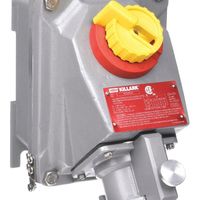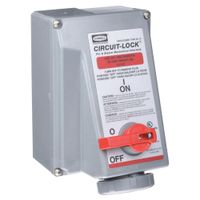Call +(254) 703 030 000 / 751 483 999 / 721 704 777
- Home
- Electrical
- Electrical Connectors Wiring Devices
- Plugs Receptacles Wiring Devices
- Mechanical Interlocks
.....Read More
Frequently Asked Questions
What are mechanical interlocks used for?
Mechanical interlocks are safety devices used to prevent dangerous or undesired actions in machinery and electrical systems. They ensure that operations occur in a specific, safe sequence, thereby reducing the risk of accidents and equipment damage.
In electrical systems, mechanical interlocks are commonly used in switchgear and circuit breakers to prevent simultaneous closure of multiple power sources, which could lead to short circuits or equipment damage. For example, in a transfer switch, a mechanical interlock ensures that the main power and backup generator cannot supply power to a load simultaneously, preventing back-feeding and potential hazards.
In industrial machinery, mechanical interlocks are used to ensure that machine components operate in a safe sequence. For instance, in a press machine, an interlock might prevent the press from operating unless a safety guard is in place, protecting operators from injury.
Mechanical interlocks are also used in multi-door systems, such as in hazardous material storage, to ensure that only one door can be opened at a time, preventing exposure to dangerous substances.
Overall, mechanical interlocks are crucial for maintaining safety and operational integrity in various applications by enforcing proper operational sequences and preventing unsafe conditions.
How do mechanical interlocks prevent electrical shocks and arcing?
Mechanical interlocks prevent electrical shocks and arcing by ensuring that electrical circuits are only engaged or disengaged under safe conditions. They achieve this through a series of physical barriers and locking mechanisms that control the sequence of operations in electrical equipment.
1. **Sequential Operation**: Mechanical interlocks enforce a specific sequence of operations. For example, they ensure that a circuit breaker cannot be closed unless the associated disconnect switch is in the correct position. This prevents accidental energization of circuits during maintenance.
2. **Physical Barriers**: Interlocks often include physical barriers that prevent access to live components. For instance, a panel door might be interlocked with the circuit breaker, so the door cannot be opened unless the breaker is in the off position, reducing the risk of accidental contact with live parts.
3. **Prevention of Simultaneous Actions**: In systems with multiple power sources, interlocks prevent the simultaneous connection of incompatible sources, such as a generator and the main power grid. This avoids dangerous back-feeding and potential arcing.
4. **Lockout Mechanisms**: Mechanical interlocks can incorporate lockout mechanisms that require a key or tool to change the state of a switch or breaker. This ensures that only authorized personnel can operate the equipment, reducing the risk of accidental or unauthorized operation.
5. **Arcing Prevention**: By ensuring that switches and breakers are operated only under no-load or low-load conditions, mechanical interlocks minimize the risk of arcing, which can occur when circuits are opened or closed under load.
Overall, mechanical interlocks enhance safety by enforcing proper operational procedures, restricting access to live components, and preventing unsafe electrical conditions, thereby reducing the risk of electrical shocks and arcing.
What safety features do mechanical interlocks have?
Mechanical interlocks are designed to ensure safety by preventing simultaneous or incorrect operation of equipment. Key safety features include:
1. **Physical Barrier**: Prevents access to hazardous areas or equipment unless certain conditions are met, ensuring safe operation.
2. **Sequential Operation**: Ensures that operations occur in a specific, safe sequence, preventing dangerous conditions from arising.
3. **Locking Mechanism**: Physically locks components in place, preventing unintended movement or operation.
4. **Key Interlock System**: Requires a key to be inserted or removed to change the state of the equipment, ensuring only authorized personnel can operate it.
5. **Tamper-Proof Design**: Constructed to resist tampering, ensuring that safety mechanisms cannot be easily bypassed.
6. **Fail-Safe Operation**: Designed to default to a safe state in the event of a failure, minimizing risk.
7. **Redundancy**: Incorporates multiple interlocks to ensure that if one fails, others will maintain safety.
8. **Durability**: Made from robust materials to withstand harsh conditions and prevent failure.
9. **Clear Indication**: Provides visual or physical indicators of the interlock status, ensuring operators are aware of the equipment state.
10. **Compatibility**: Designed to work with specific equipment, ensuring proper fit and function.
These features collectively ensure that mechanical interlocks provide a reliable means of safeguarding machinery and personnel by controlling access and operation in a structured and secure manner.
How do mechanical interlocks ensure watertight protection?
Mechanical interlocks ensure watertight protection by creating a secure and tight seal between two or more components, preventing the ingress of water. These interlocks are designed to engage precisely, often using complementary shapes or locking mechanisms that fit together snugly. When engaged, they apply pressure across the sealing surfaces, compressing any gaskets or seals in place to form a barrier against water penetration.
The effectiveness of mechanical interlocks in providing watertight protection relies on several factors:
1. **Precision Engineering**: The components involved must be manufactured to exact specifications to ensure a perfect fit. Any deviation can compromise the seal and allow water to enter.
2. **Material Selection**: The materials used for both the interlocking components and the seals must be resistant to water and environmental conditions. Common materials include rubber, silicone, and specialized polymers that maintain their integrity under pressure and temperature variations.
3. **Seal Design**: The design of the seal is crucial. It must be able to withstand the forces applied by the interlock without deforming or degrading. O-rings, gaskets, and lip seals are commonly used to enhance the watertight properties.
4. **Force Distribution**: The interlock must distribute force evenly across the seal to prevent weak points where water could penetrate. This often involves using multiple interlocking points or a continuous locking edge.
5. **Maintenance and Inspection**: Regular maintenance and inspection ensure that the interlock and seals remain in good condition. Any wear or damage can be addressed promptly to maintain watertight integrity.
By combining these elements, mechanical interlocks provide a reliable method for achieving watertight protection in various applications, from underwater equipment to electronic enclosures.
Can mechanical interlocks be used in hazardous locations?
Yes, mechanical interlocks can be used in hazardous locations, but they must be specifically designed and certified for such environments. Hazardous locations are areas where flammable gases, vapors, dust, or fibers may be present, creating a risk of explosion or fire. In these areas, equipment must meet stringent safety standards to prevent ignition.
Mechanical interlocks used in hazardous locations must comply with relevant standards such as the National Electrical Code (NEC) in the United States, or the ATEX directive in the European Union. These standards ensure that the interlocks are constructed to prevent sparks or high temperatures that could ignite hazardous substances.
The design of mechanical interlocks for hazardous locations often includes features such as:
1. **Explosion-proof enclosures**: These enclosures are designed to contain any explosion that might occur within the device, preventing it from igniting the surrounding atmosphere.
2. **Intrinsically safe components**: These components are designed to operate with low energy levels that are insufficient to cause ignition.
3. **Dust-tight and weatherproof seals**: These prevent the ingress of dust and moisture, which could compromise the safety and functionality of the interlock.
4. **Corrosion-resistant materials**: These materials ensure durability and reliability in harsh environments.
Before installation, it is crucial to verify that the mechanical interlock is certified for the specific type of hazardous location it will be used in, such as Class I, Division 1 or 2 for gases and vapors, or Class II, Division 1 or 2 for dusts, according to the NEC classification.
In summary, while mechanical interlocks can be used in hazardous locations, they must be appropriately designed, certified, and installed to ensure safety and compliance with applicable regulations.
What materials are used in the construction of mechanical interlocks?
Mechanical interlocks are devices used to prevent simultaneous operation of multiple components, ensuring safety and proper sequencing in machinery and electrical systems. The materials used in their construction are chosen for durability, strength, and resistance to environmental factors. Key materials include:
1. **Metals**:
- **Steel**: Often used for its strength and durability. Stainless steel is preferred for its corrosion resistance.
- **Aluminum**: Lightweight and corrosion-resistant, used where weight is a concern.
- **Brass**: Offers good corrosion resistance and is used in components requiring low friction.
2. **Plastics**:
- **Nylon**: Known for its toughness and wear resistance, often used in moving parts.
- **Polycarbonate**: Offers high impact resistance and is used in transparent components.
- **ABS (Acrylonitrile Butadiene Styrene)**: Provides good impact resistance and toughness.
3. **Composites**:
- **Fiberglass**: Used for its strength-to-weight ratio and electrical insulation properties.
- **Carbon Fiber**: Employed in high-performance applications for its strength and lightweight characteristics.
4. **Elastomers**:
- **Rubber**: Used for seals and gaskets due to its flexibility and sealing properties.
- **Silicone**: Offers high-temperature resistance and is used in seals and gaskets.
5. **Ceramics**:
- Used in high-temperature applications for their thermal resistance and electrical insulation properties.
These materials are selected based on the specific requirements of the interlock, such as mechanical strength, environmental conditions, electrical insulation, and cost considerations. The combination of these materials ensures that mechanical interlocks function reliably and safely in various industrial applications.
How do mechanical interlocks prevent mismatched connections?
Mechanical interlocks prevent mismatched connections by using physical barriers and alignment mechanisms to ensure that only compatible components can be connected. These interlocks are designed to align and engage only when the correct parts are used, thereby preventing incorrect or unsafe connections.
1. **Physical Barriers**: Mechanical interlocks often include physical barriers that block the insertion of incompatible connectors. These barriers can be in the form of pins, tabs, or slots that must align perfectly for the connection to be made. If the components do not match, the barriers prevent engagement.
2. **Keying Systems**: Many interlocks use keying systems, where connectors have unique shapes or patterns that must match. This ensures that only the correct plug can fit into the corresponding socket. The keying system can include different pin configurations, shapes, or sizes that are unique to each connection type.
3. **Sequential Engagement**: Some interlocks require a specific sequence of operations to engage the connection. This can involve turning, sliding, or pressing components in a particular order, which ensures that only trained personnel using the correct parts can make the connection.
4. **Locking Mechanisms**: Mechanical interlocks may include locking mechanisms that secure the connection once it is made. These locks prevent accidental disconnection and ensure that the connection remains stable during operation.
5. **Visual and Tactile Feedback**: Interlocks often provide visual or tactile feedback to confirm a correct connection. This can include clicks, snaps, or visual indicators that show when the connection is properly engaged.
By incorporating these features, mechanical interlocks effectively prevent mismatched connections, enhancing safety and reliability in various applications, such as electrical systems, industrial machinery, and data centers.

